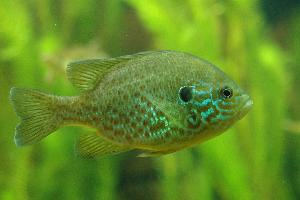
Weights and measures
| Length | from 12 to 40 cm |
|---|
Biological data
| Lifespan | from 9 to 10 years |
|---|
Animal description
The True sunfish, belonging to the genus Lepomis, comprises a distinctive and fascinating group of freshwater fish predominantly found in the waterways of North America. These fish are part of the Centrarchidae family, which also includes crappies and large-mouth bass, showcasing a rich diversity in size, color, and habitat preferences. The genus Lepomis is renowned for its vibrant colors and intricate patterns, making these sunfish not only a favorite among anglers but also a subject of interest in ecological studies.Physical Characteristics:
True sunfish exhibit a laterally compressed, almost disc-shaped body which aids in their agility and maneuverability in the aquatic environment. Sizes can vary significantly among the species within this genus, with adult specimens ranging from as small as 4 inches to over 16 inches in length, depending on the species. Their bodies are adorned with striking colors and patterns, including vibrant blues, greens, oranges, and reds, often with speckles or stripes that serve as camouflage or mating displays. The males are typically more brightly colored than the females, especially during the breeding season.
One of the most distinctive features of the True sunfish is their dorsal fin, which is divided into a spiny front section and a softer, rayed rear section. This unique fin structure is a key characteristic of the Centrarchidae family. Their mouths are relatively small, especially when compared to other members of their family, like the largemouth bass, reflecting their diet of smaller prey items.
Habitat and Distribution:
True sunfish are highly adaptable and can be found in a variety of freshwater habitats across North America, from slow-moving rivers and streams to lakes and ponds. They prefer areas with abundant vegetation or other structures, such as logs and rocks, which provide shelter from predators and serve as hunting grounds for their prey. Water clarity can vary widely across their habitats, from the clear, vegetated waters preferred by species like the Bluegill (Lepomis macrochirus) to the murkier environments favored by others.
Diet and Behavior:
The diet of True sunfish primarily consists of small invertebrates, including insects, crustaceans, and other aquatic organisms. They are opportunistic feeders, often hunting in the shelter of aquatic vegetation or along the water's edge. Their feeding behavior can change with the seasons, influenced by water temperature and the availability of prey.
Reproduction:
True sunfish are known for their elaborate breeding rituals, which typically occur in the warmer months. Males become even more brightly colored during this time and construct circular nests on the substrate by fanning out depressions with their fins. They then fiercely defend these nests and attract females to lay eggs, which the males subsequently guard until they hatch. This parental care is relatively rare among fish and highlights the complex social behaviors of these species.
Conservation Status:
While many species within the Lepomis genus are abundant and not currently considered at risk, habitat degradation, pollution, and competition from invasive species pose ongoing threats to their populations. Conservation efforts focus on maintaining healthy waterways, controlling invasive species, and promoting sustainable fishing practices to ensure the continued survival of these vibrant and ecologically important fish.
In summary, True sunfish are a diverse and colorful group of freshwater fish that play significant roles in their ecosystems. Their adaptability to different environments, striking appearance, and complex behaviors make them a fascinating subject of study and a beloved target for recreational fishing.
New photos of animals
Top 10 animals
- Dolphin gull (Leucophaeus scoresbii)
- Japanese macaque (Macaca fuscata)
- Stone loach (Barbatula barbatula)
- Greek tortoise (Testudo graeca)
- Galápagos tortoise (Geochelone nigra complex)
- Diana monkey (Cercopithecus diana)
- Russian tortoise (Testudo horsfieldii)
- Moustached guenon (Cercopithecus cephus)
- Galápagos penguin (Spheniscus mendiculus)
- Common flying dragon (Draco volans)